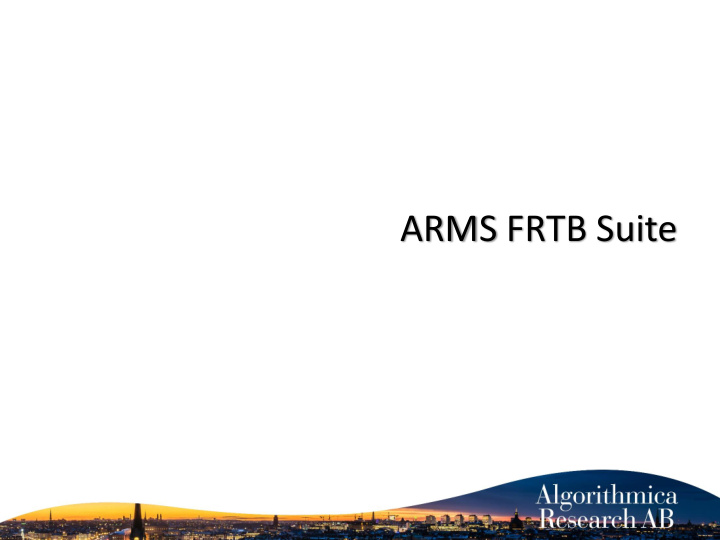



ARMS FRTB Suite
Challenges of FRTB • Need to optimize trading desk structures in order to Capital charges minimize capital costs • IMA approval requires FO/MO alignment of models and Architecture market data Technical • Significantly increased performance requirements • Need for extended risk factor sets and careful quality Market Data assessments Operational • New tools needed to perform new processes Implementation • Must adhere to aggressive Basel III timeline
FRTB overview New standard market risk model ❖ Sensitivity based risk model more in-line with actual risk taking ❖ May be required to import sensitivities from PnL generating system ❖ Non-linear netting of risks in buckets and between buckets (incl stressed correlations) ❖ All banks required to report to regulator on monthly basis New requirements on internal market risk model ❖ Riskmodel must be expected shortfall ❖ Calculation based on full and reduced risk factor set and stressed period ❖ PnL explained to a certain level ❖ VaR backtesting requirements ❖ Special handling of non-modellable riskfactors ❖ Requirement to use Default Risk Model
ARMS FRTB process flow Ext. flows Internal model flow (IMA) Aggregation from Presentation Positions + 90 Expected bottom up using APIs, shortfall calc Risk factors + Dashboard and Include external (6 a*5 liq*3 set) Classifications Disk PnLs Ext. flows Standard model flow (SMA) Automapping to Aggregation from Presentation Positions + reg. risk factors bottom up using APIs, Risk factors + Dashboard and + calc Include external Issue(r) static Disk sensitivities sensitivities
ARMS FRTB Desk Dashboard
ARMS FRTB Dashboard drill-down
ARMS FRTB - Simulate and Explain
Simple and unified position and data model • FRTB standard model capital charge (using full reval) • FRTB internal model charge (using full reval) Optional: • Internal risk such as trading VaR, Stresstesting etc • Counterparty credit risk - PFE and CVA • Flexible cashflow generation for liquidity Parallel calculations on inexpensive hardware • Open code repository with APIs • Efficient and fast calculation factory • Low cost of ownership Local support and development • Fast on-site response • Quick development turn-arounds • Development fee reductions for system owners
ARMS Real-time Server Multi CPU/ FO core Real-time worker Real-time nodes BO End-of-day ARMS FRTB Module Market Data Import of ARMS Core Engine AHS positions/ Powered by transactions ARMS CCR Module Quantlab End of day End of day from FO/BO Database systems Streaming API Webservice API File-based (XML) API ARMS RT Clients Bank -intranet clients
ARMS Real-time Server – result data aggregation The ARMS server includes our rQube ™ in-memory database, combining a traditional multidimensional OLAP cube with a hierarchical tree-graph for superior risk data aggregation and supporting minimal transactional recalculation for ultrafast real-time performance.
3rd party tool integration made easy The ARMS FRTB solution is implemented in Qlang, making it uniquely modular and flexible. With the performance of native optimized code, Qlang offers speed and code quality far beyond the scripting languages used by competing products. An ARMS API Server acts as a host for varios protocols such as Json, Webservice and Rest type calls. It can embed its own cached results for fast access of previously calculated data and triggers for re-calculations when needed.
Recommend
More recommend